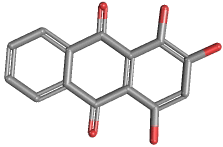|
PURPURIN |
| Synonyms. Purpurin; 1,2,4-Trihydroxy-9,10-anthracenedione; 1,2,4-Trihydroxyanthraquinone; 1,2,4-Trihydroxy-9,10-anthraquinone; 1,2,4-Trihydroxyanthrachinon; C.I. 1037; C.I. 58205; C.I. 75410; Hydroxylizaric acid; Purpurin madder root; Purpurine; Smoke Brown G; Verantin; |
|
|
| PRODUCT IDENTIFICATION | |
|
CAS RN |
81-54-9 |
|
EINECS RN |
201-359-8 |
|
FORMULA |
C14H8O5 |
|
MOLE WEIGHT |
256.21 |
|
H.S CODE |
3204.19.4000 |
|
SMILES |
c12c(C(c3ccccc3C1=O)=O)c(cc(c2O)O)O |
|
CLASSIFICATION |
Coloring agent, Anthraquinone dye, Hydroxyquinol, Trihydroxyanthraquinone |
|
EXTRA NOTES |
A natural pigment from roots of madder root (Rubia tinctorum). |
|
|
| PHYSICAL AND CHEMICAL PROPERTIES | |
|
PHYSICAL STATE. |
dark brown powder |
|
MELTING POINT |
253 ~ 256 C |
|
BOILING POINT |
|
|
DENSITY |
|
|
SOLUBILITY IN WATER |
Slightly soluble |
| SOLVENT SOLUBILITY |
|
|
VAPOR DENSITY |
|
|
log P(octanol-water) |
3.46 |
|
VAPOR PRESSURE |
|
|
AUTOIGNITION TEMP |
|
| pK |
|
|
REFRACTIVE INDEX |
|
|
FLASH POINT |
113 C |
|
|
| STABILITY AND REACTIVITY | |
| STABILITY | Stable under normal conditions. |
|
INCOMPATIBLE MATERIALS |
Strong oxidizing agents |
| POLYMERIZATION |
Has not been reported |
|
NFPA RATINGS |
Health: 2, Flammability: 1, Reactivity: 0 |
|
|
| EXTERNAL LINKS & GENERAL DESCRIPTION |
|
USA.gov - Purpurin Wikipedia Linking - 1,2,4-Trihydroxyanthraquinone Google Scholar Search - Purpurin Drug Information Portal (U.S. National Library of Medicine) - Purpurin PubChem Compound Summary - Purpurin KEGG (Kyoto Encyclopedia of Genes and Genomes) - Purpurin http://www.ebi.ac.uk/chebi/ - Purpurin http://www.ncbi.nlm.nih.gov/ - Purpurin Material Safety Data Sheet - Purpurin EPA - Substance Registry Services - Purpurin |
|
|
| SALES SPECIFICATION | |
|
APPEARANCE |
dark brown powder |
|
ASSAY |
95% min (HPLC) |
|
Alizarin |
3% max |
|
LOSS ON DRYING |
1% max |
|
MELTING POINT |
253 ~ 256 C |
|
|
| TRANSPORT & REGULATORY INFORMATION | |
|
UN NO. |
|
| HAZARD CLASS |
|
| PACKING GROUP | |
|
|
| SAFETY INFORMATION | |
|
HAZARD OVERVIEW |
OSHA Hazards: Target Organ Effect, Irritant, Teratogen. Causes eye, skin, and respiratory tract irritation. Target Organs: Respiratory system, eyes, skin. Eye: Causes eye irritation. Skin: Causes skin irritation. Ingestion: May cause gastrointestinal irritation with nausea, vomiting and diarrhea. Inhalation: Causes respiratory tract irritation. |
| SIGNAL WORD | Warning |
|
PICTOGRAMS |
|
|
HAZARD STATEMENTS |
H315-H319-H335 |
|
P STATEMENTS |
P261-P305 + P351 + P338 |
| EC DIRECTIVES |
|
| HAZARD CODES |
|
|
RISK PHRASES |
36/37/38 |
|
SAFETY PHRASES |
26-36 |
|
|
| PACKING |
|
Preserve in light-resistant and well-closed containers |
|
|

